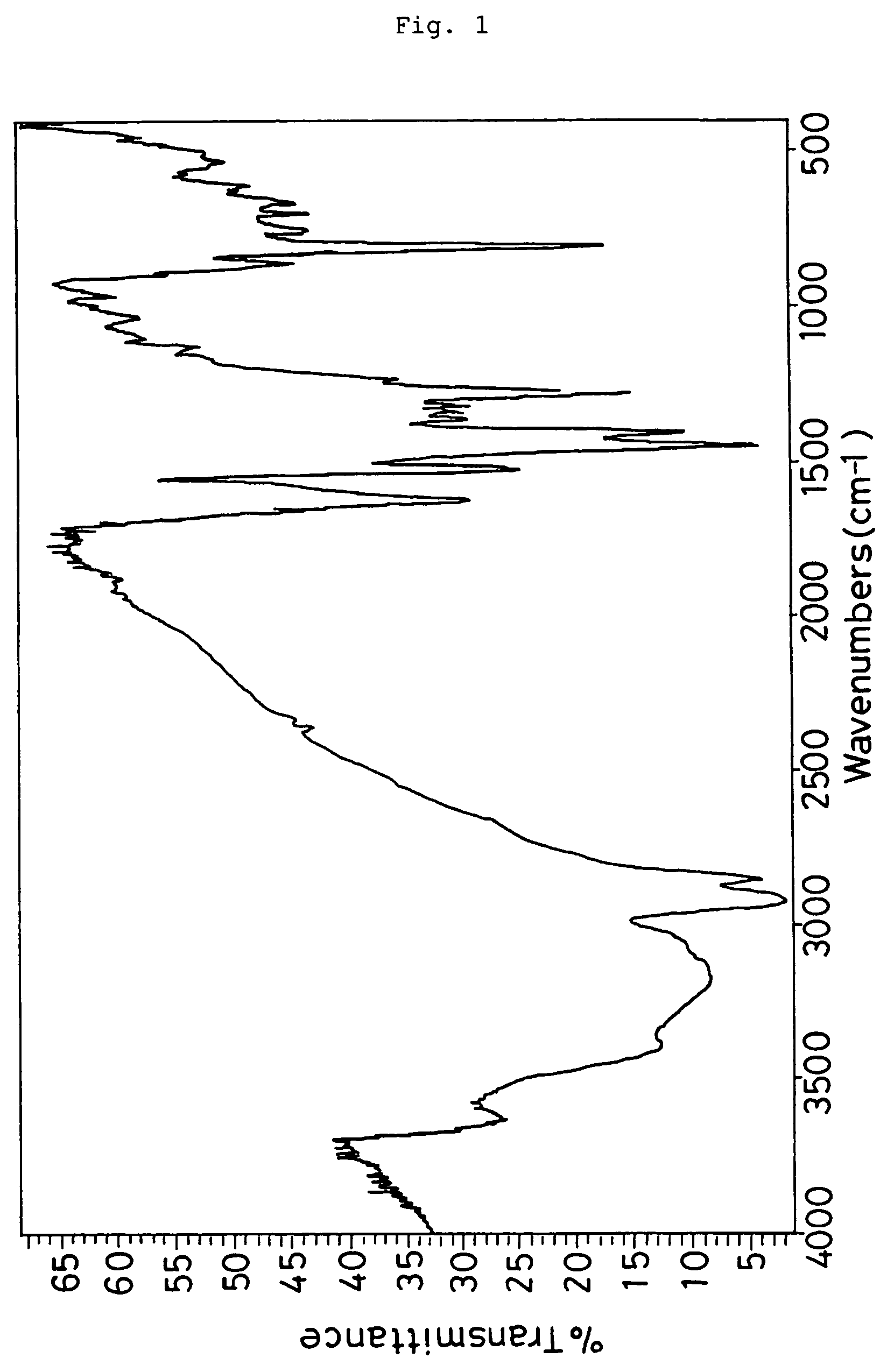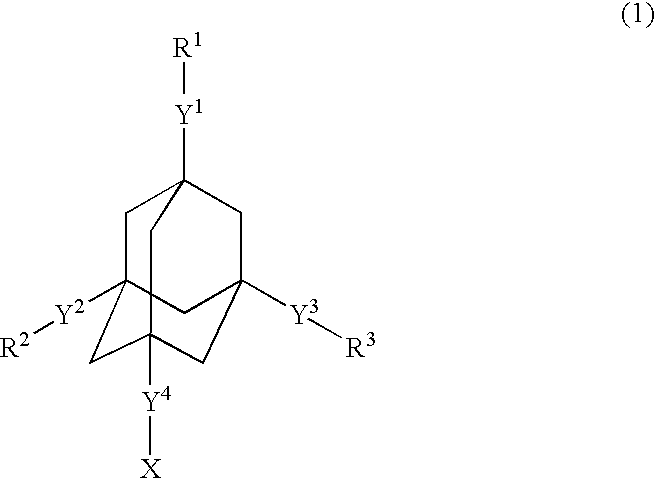Dielectric films and materials therefor
a dielectric film and film technology, applied in the direction of solid-state devices, metal-layer products, synthetic resin layered products, etc., can solve the problems of low dielectric constant, inability to significantly apply a substrate, and inability to meet industrial production methods, etc., to achieve sufficient thickness, improve solubility, and improve the effect of solvent solubility
- Summary
- Abstract
- Description
- Claims
- Application Information
AI Technical Summary
Benefits of technology
Problems solved by technology
Method used
Image
Examples
preparation example 1
Preparation of trimethyl ester of 1,3,5-adamantanetricarboxylic acid
[0117]
[0118]In a 200-ml flask equipped with a stirrer, a condenser and a thermometer were placed 26.8 g (100 mmol) of 1,3,5-adamantanetricarboxylic acid, 100 ml of methanol and 0.49 g (5 mmol) of sulfuric acid, followed by heating under reflux in a nitrogen atmosphere for 3 hours. After cooling to room temperature, methanol was removed under reduced pressure, and the reaction mixture was dissolved in ethyl acetate. The solution was washed with 10% aqueous solution of sodium carbonate and water to remove a residual acid component. Ethyl acetate was removed from the ethyl acetate solution under reduced pressure to yield 27.3 g (88 mmol) of trimethyl ester of 1,3,5-adamantanetricarboxylic acid in a yield of 88%.
[0119][NMR Spectral Data]
[0120]1H-NMR (CDCl3) δ (ppm): 1.84 (m, 6H), 2.01 (m, 6H), 2.30 (m, 1H), 3.65 (m, 9H)
[0121]13C-NMR (CDCl3) δ (ppm): 27.86, 37.06, 39.11, 41.28, 51.91, 176.40
preparation example 2
Preparation of 1,3,5-adamantanetricarbonyl trichloride
[0122]
[0123]In a 200-ml flask equipped with a stirrer, a condenser, a thermometer and an acidic gas trap were placed and stirred 26.8 g (100 mmol) of 1,3,5-adamantanetricarboxylic acid and 59.5 g (500 mmol) of thionyl chloride. To the mixture was added dropwise 0.37 g (5 mmol) of dimethylformamide (DMF) at room temperature, and the mixture was gradually heated and stirred at 70° C. in a nitrogen atmosphere for 3 hours. After cooling to room temperature, the residual thionyl chloride and DMF were removed under reduced pressure, to yield 31.4 g (97 mmol) of 1,3,5-adamantanetricarbonyl trichloride in a yield of 97%.
[0124][NMR Spectral Data]
[0125]1H-NMR (CDCl3) δ (ppm): 1.74 (m, 6H), 1.95 (m, 6H), 2.33 (m, 1H)
[0126]13C-NMR (CDCl3) δ (ppm): 27.70, 36.52, 39.89, 51.21, 178.63
preparation example 3
Preparation of tri-tert-butyl ester of 1,3,5-adamantanetricarboxylic acid
[0127]
[0128]In a 500-ml flask equipped with a stirrer, a thermometer and a dropping funnel were placed 32.6 g (340 mmol) of sodium tert-butoxide and 140 ml of toluene. To the stirred mixture under ice-cooling in a nitrogen atmosphere, 31.4 g (97 mmol) of 1,3,5-adamantanetricarbonyl trichloride in 190 ml of toluene was added dropwise over 1 hour. This was warmed to room temperature, was stirred for further 1 hour and was washed with water, followed by removal of the solvent under reduced pressure. The residue was mixed with methanol and was further mixed with water with stirring under ice-cooling, to yield crystals of the target compound. The crystals were collected by filtration through a Nutsche funnel, were rinsed with a mixture of distilled water and methanol and were dried, to yield 38.1 g (87 mmol) of tri-tert-butyl ester of 1,3,5-adamantanetricarboxylic acid in a yield of 90%.
[0129][NMR Spectral Data]
[013...
PUM
| Property | Measurement | Unit |
|---|---|---|
| Dielectric polarization enthalpy | aaaaa | aaaaa |
Abstract
Description
Claims
Application Information
 Login to View More
Login to View More - R&D
- Intellectual Property
- Life Sciences
- Materials
- Tech Scout
- Unparalleled Data Quality
- Higher Quality Content
- 60% Fewer Hallucinations
Browse by: Latest US Patents, China's latest patents, Technical Efficacy Thesaurus, Application Domain, Technology Topic, Popular Technical Reports.
© 2025 PatSnap. All rights reserved.Legal|Privacy policy|Modern Slavery Act Transparency Statement|Sitemap|About US| Contact US: help@patsnap.com



